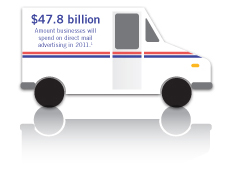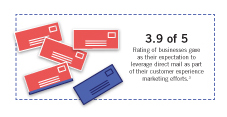Direct mail and the changing US Postal Service.
You’ve probably noticed that your mailbox isn’t quite as full as it used to be. First class mail volumes (historically the most profitable segment for the U.S. Postal Service) have fallen at a staggering rate as many previously printed forms of business and personal communications have gone digital.
Printed direct mail volumes have fallen over the past several years, as well, as many direct marketing efforts have moved online. That being said, many marketers still find printed direct mail to be a useful component of an integrated marketing plan. Financial services, publishing, mobile telephone and cable/satellite television providers remain large users of direct mail. As a group, the largest direct mail user perennially is the nonprofit sector. And many luxury merchandise providers continue to count on direct mail to deliver printed catalogs, brochures and invitations, as their target markets have been slower to adopt electronic alternatives.
As the drop in mail volume has financially strapped the Postal Service, several proposals have been put forth, including reducing the Postal Service workforce, eliminating Saturday delivery (or more) and closing facilities. However, if these proposals eventually play out, marketers need to understand that direct mail is very likely to get slower and costlier.
 Even if today’s volumes stabilize, removing Saturday delivery obviously increases the amount of mail at the mailbox the other five days of the week, as well as decreases the point-of-response for many households from six to five opportunities per week. To attempt to maintain open rates, direct mail marketers will respond with increasingly creative shapes, colors of carrier envelope/postcard graphics and offers to attract attention.
Even if today’s volumes stabilize, removing Saturday delivery obviously increases the amount of mail at the mailbox the other five days of the week, as well as decreases the point-of-response for many households from six to five opportunities per week. To attempt to maintain open rates, direct mail marketers will respond with increasingly creative shapes, colors of carrier envelope/postcard graphics and offers to attract attention.
Reductions in the Postal Service workforce and facilities add up to longer processing and in-transit times, creating problems for marketers attempting to integrate campaigns across multiple media platforms. Marketers will respond by adjusting what was previously viewed as supportive advertising to include a short-form “call to action” that mirrors the longer-form printed direct mail piece.
 The increased cost of printed direct mail will have a two-fold effect on marketers. First of all, marketers who have, for years, used direct mail as the core of their advertising efforts will evaluate return-on-investment for other direct and indirect tactics. Secondly, for those marketers who choose to keep a direct mail component in their methodologies, all components will come under much closer scrutiny. List quality, or “goodness of list,” will be critical as marketers look to decrease wasted volumes of direct mail, while maintaining response rates. And many of the targeting, propensity-to-respond and testing models that sophisticated direct mailers use today will, in light of the increased costs for shotgun mailing, progress to smaller or less frequent mailers.
The increased cost of printed direct mail will have a two-fold effect on marketers. First of all, marketers who have, for years, used direct mail as the core of their advertising efforts will evaluate return-on-investment for other direct and indirect tactics. Secondly, for those marketers who choose to keep a direct mail component in their methodologies, all components will come under much closer scrutiny. List quality, or “goodness of list,” will be critical as marketers look to decrease wasted volumes of direct mail, while maintaining response rates. And many of the targeting, propensity-to-respond and testing models that sophisticated direct mailers use today will, in light of the increased costs for shotgun mailing, progress to smaller or less frequent mailers.
In short, there are still many reasons that printed direct mail works. Direct response advertisers still find the ability to target at a household- or business-level, the cost per contact and the ease of list acquisition to be an unbeatable combination. As the Postal Service and Congress work through the financial struggles of the Postal Service, marketers need to evaluate other means of outreach and how to reduce waste in their direct mail programs.


